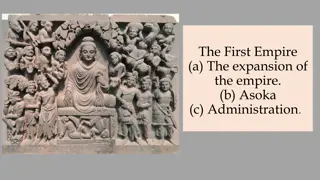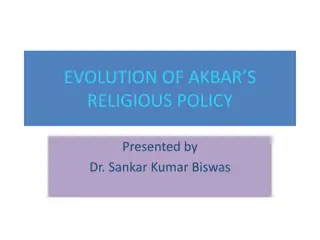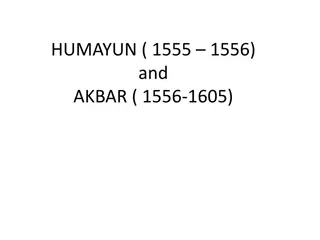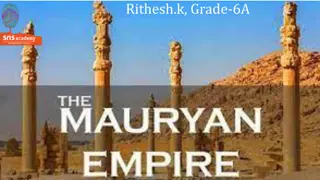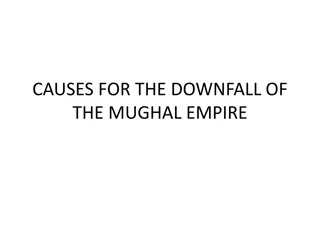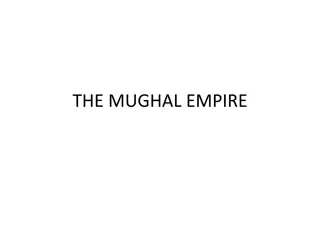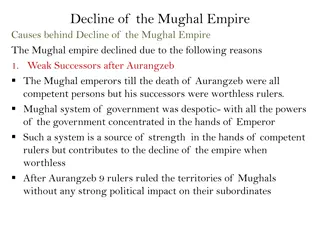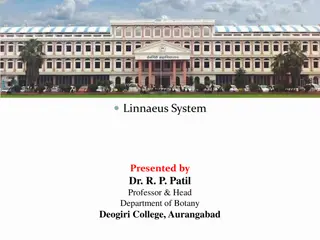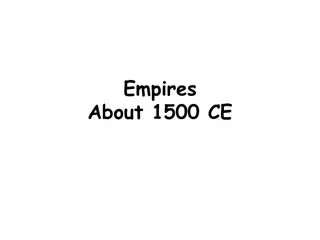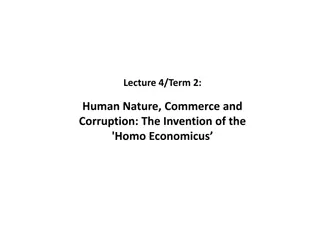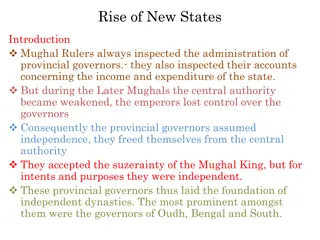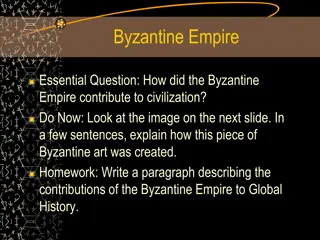Outline of Mughal Empire Mughal Empire 1526-1707.
The Mughal Empire in India from 1526 to 1707 was a significant period marked by notable rulers such as Babur, Humayun, Akbar, Jehangir, Shah Jehan, and Aurangzeb. These emperors each contributed differently to the empire's development, with highlights including military conquests, administrative reforms, religious tolerance, and architectural achievements.
Download Presentation

Please find below an Image/Link to download the presentation.
The content on the website is provided AS IS for your information and personal use only. It may not be sold, licensed, or shared on other websites without obtaining consent from the author.If you encounter any issues during the download, it is possible that the publisher has removed the file from their server.
You are allowed to download the files provided on this website for personal or commercial use, subject to the condition that they are used lawfully. All files are the property of their respective owners.
The content on the website is provided AS IS for your information and personal use only. It may not be sold, licensed, or shared on other websites without obtaining consent from the author.
E N D
Presentation Transcript
Outline of Mughal Empire Mughal Empire 1526-1707 Suman Patra Assistamt Professor Department of History Chandidas Mahavidyalaya
Introduction Under the Mughals, India was the heart of a great Islamic empire and a prolific center of Islamic culture and learning. Dynasty was the greatest, richest and longest lasting Muslim dynasty to rule India. Mongol Descendents The Great Mughal Emperors were: Babur (1526-1530) The First of the Mughals Humayun (1530-1556) The Luckless Leader Akbar (1556-1605) The Great Jehangir (1605-1627) The Paragon of Stability Shah Jehan (1627-1658) The Master Builder Aurangzeb (1658-1707) The Intolerant
Babur 1526 - 1530 The First of the Mughals Babur was a direct descendant of the Turkish Ghengis Khan and Timur from Tamerlane. (Rumor has it Adele) Defeated the Delhi Sultanate & established the Mughal Empire. Gunpowder, a skilled commander, trained soldiers on horses contributed to the victory Gained control of the whole northern India Made Agra capital He reigned for 4 short years and died at age 47 in 1530. Did not enact new laws or organization in the empire due to early his death
Humayun 1530 - 1556 The Luckless Leader After Babur died, he was succeeded by his son Humayun in 1530. Humayun was 23 years old. He was not a soldier and unlike his father, neither skilled nor a wise leader. Inherited a disunited and disorganized empire. In 1540, Sher Shah of Bengal defeated Humayun and took over the Mughal Empire. The Empire was lost from 1540-1545. He was exiled but later regained power in 1555. Humayun died in 1556 after falling down the steps of his library; he is known as the luckless one .
Akbar 1556 - 1605 The Great Akbar become the new Mughal ruler at the age of 14. Regent and his mother ruled in his name for 4 years Akbar was an ambitious and noble commander Built the largest army ever in the empire. Helped to conquer nearly all of modern-day northern India and Pakistan. Great administrator developed a centralized government It delegated 15 provinces each under a governor and each province into districts and each district was further sub-divided into smaller sections. Best known for tolerance of his subjects (especially Hindus) Removed poll taxes on Hindus Invited religious scholars to debate him in his private chambers. Developed his own faith call Din Ilahi. Din Ilahi was a mixture of the other religions Akbar had studied from those debates. Religion never caught on
Jehangir 1605 - 1627 The Paragon of Stability Jehangir succeeded his father Akbar in 1605. Opposite of his father Poor monarch and warrior but good at maintaining the status quo. He continuedmany of Akbar s policies. Freedom of worship. Fair treatment of Hindus. Continued friendship and alliance with Rajputs. Allowed foreigners like the Portuguese and English into India for trade. Jehangir married Nur Jahan. She became the real ruler of the empire until the death of her husband.
Jehangir Issues (specific) Under the influence of his wife and many others, Jehangir was not an able ruler like his father. He loved to drink and enjoy himself. He had to suppress many rebellions. Important posts in the court were given to families, friends, and especially those close to his wife, Jahan.
Shah Jehan 1627 - 1658 The Master Builder Shah Jehan succeeded his father in 1627. Better ruler than Jehangir. Restored the efficiency of government. Recovered territories. Maintained peace Foreign traders were allowed into India and trade increased considerably. The empire was expanded. Shah Jehan was a patron of the arts Built many great architecture buildings including the Taj Mahal and the Peacock Throne, a brilliant gold throne encased in hundreds of precious gems.
Shah Jehan Taj Mahal Built in honor of his wife who died during childbirth. Took over a decade to build and it nearly bankrupted the empire. 1657 - Shah Jehan became seriously ill and a dispute over the succession of the throne ensued between his three sons. Aurangzeb deposed Shah Jehanin a coup d etat in 1658. Shah Jehan was imprisoned in the Octagonal Tower of the Agra Fort from which he could see the Taj Mahal. He died in 1666 and was buried next to his wife in the Taj Mahal.
Aurangzeb 1658 - 1707 The Intolerant Aurangzeb ascended the throne after disposing his father and beating out his two brothers. Despot severely persecuted Hindus of Northern India. Empire declines under his reign He removed the tax-free status for Hindus Destroyed their temples Crushed semi-autonomous Hindu states Primary Interest - Promote Islam vs tolerance
Aurangzeb Aurangzeb over expanded the empire and strained his resources. Large sums of money and manpower were lost. He lost the support of the Hindu people. The over expansion of his empire weakened his administration. Aurangzeb died in 1707 s son Bahadur Shah succeeded him. Bahadur was so old by the time he ascended the throne, he only managed to live a few more years. But at this point in time, the government was so unstable and so weak, the empire become an easy target of invasion and exploitation, first by the Persians, and then by the British. The death of Aurangzeb and the short reign of his son led to the end of the Mughal empire and the beginning of British Rule.
The Success of the Mughals It is agreed among many scholars that the Mughal empire was the greatest, richest and most long-lasting Muslim dynasty to rule India. This period of Mughal rule produced the finest and most elegant art and architecture in the history of Muslim dynasties. The Mughal emperors, with few exceptions, were among the world s most aesthetically minded rules. Although Turkish and Persian in background, the Mughals were not Muslim rulers of India but Indian rulers who happened to be Muslims. This idea is most evident in Akbar s obsession of a utopian India for Hindus and Muslims. The longevity of the Mughal empire can be contributed to a number of factors. The Mughal emperors were ambitious and for the most part able rulers. But Akbar is perhaps the Mughal emperor responsible for much of the prosperity and harmony achieved during the Mughal Empire.
Akbar the Great, as he is referred, perceived that 3 things were needed if his Empire was to be stable and long-lasting. 1. Fair rent must be fixed for the peasant and a steady revenue for the treasury, 2. The land must be ruled by men who were impartial and responsible to himself, 3. The Muslim must live at peace with the Hindu. Akbar strove during his lifetime to achieve these 3 things. He showed tolerance to Hindu scholars and women. By 1650, the Mughal empire had expanded farther North and South.



